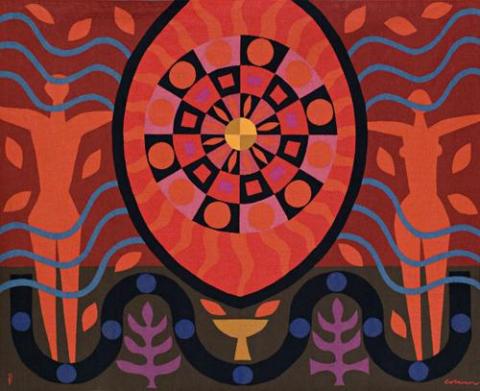THE SIXTH DAY: GOD CREATED MAN, 1969-70
John Coburn
wool tapestry
186.0 x 230.0 cm
signed and inscribed on label sewn verso: "THE 6TH DAY: GOD CREATED/ MAN"/ COBURN/ COBURN woven at Tapisserie D'Aubusson, France
Aubusson Tapestries, Bonython Galleries, Sydney, 21 April-13 May 1970, and touring to Melbourne, Adelaide, and Perth
Thomas, D.E.L., 'John Coburn's Curtains', Sydney Opera House Special Number, Art and Australia, vol.11, no.3, Summer 1974, pp.256 & 261
Rozen, A., The Art of John Coburn, Ure Smith, Sydney, 1979, p.66, pl.32 (illus.)
Other examples of this edition are housed in the collections of the John F. Kennedy Centre for the Performing Arts, Washington, USA and the ANZ Bank Collection, Melbourne
John Coburn was one of Australia's finest designers of tapestries, his opus magnum being the huge curtains for the Sydney Opera House, the Curtain of the Sun and Curtain of the Moon. The seven Creation tapestries are one of his most important series, designed in Canberra in 1969 and woven in Aubusson in 1970 in sumptuous colours. Following his first tapestry, In Praise of the Sun 1966, Coburn went to France three years later to supervise the weaving of the Creation and Opera House tapestries at Aubusson. His abstract style and the French weavers' skill were an ideal combination, the mix that created masterpieces.
The inspiration for the epic Creation series was, typically, immediate, in one day from seven rough sketches.' I knew that I had embarked on a major work and I decided to make them into a series of tapestries.'1 His sixth day presents the circle symbol of God, ringed with tongues of life-giving fire, enclosed within the mandala and pulsating life to the figurative shapes of the first man and woman. Beneath, the black snake symbol twists darkly around the feet of Adam and his Eve. The tapestry glows with red, the liturgical colour of the Holy Spirit and the earthly blood of life.
1. John Coburn quoted in Thomas, op.cit., p.256
DAVID THOMAS
